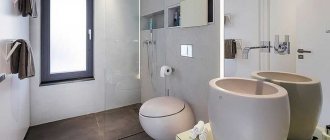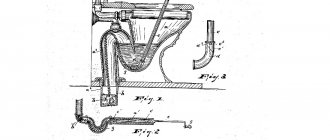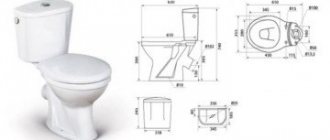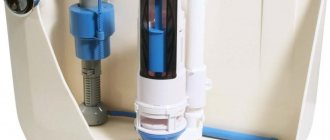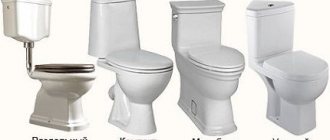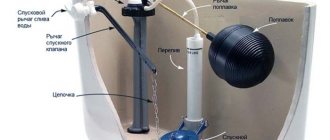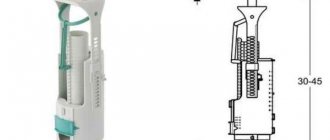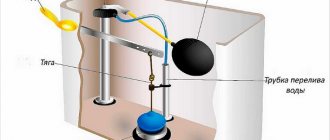Recently, so-called tankless toilets have become very popular. It should be noted right away that in most cases they have a tank, but only it is hidden in the wall. Below we will look in detail at how a toilet without a tank works, what types of plumbing there are and its features.
Toilet without cistern
Pros and cons of the system
The main advantages of tankless toilets include their compactness, since the communication pipes are hidden in the wall. Due to the fact that the design of this type of toilet is smaller than that of a conventional device, the usable area of the bathroom is saved.
Minimalism and compactness of the product play a very important role when installing it in a small bathroom, since the space expands not only visually, but also actually. The absence of condensation, which occurs in the cistern when cold water is supplied to a conventional toilet model, is also of great importance for the use of plumbing in small bathroom areas.
Of course, the model has some disadvantages, one of which is high cost. The disadvantages include noise during flushing, in contrast to classical types of plumbing. In addition, if the water supply is turned off, the system will not work.
When performing maintenance and repairs, be especially careful when working, as there is a risk of damaging the finish of the bathroom, since communications are built into the wall. In addition, when installing a tankless toilet, it is best to entrust the installation work to specialists, since the installation is fraught with technological difficulties.
General information
Advantages
The main advantage of toilets without a tank is their attractiveness, since all its communications are hidden behind the wall. Therefore, they look unusual and modern, thanks to which the bathroom takes on a completely different look.
In addition, such plumbing equipment has some other advantages:
- The design is shorter than a traditional toilet, which saves space in the bathroom.
- Excellent hygiene, since such a plumbing fixture is easier to clean.
- Due to the absence of a tank, the room visually expands.
- Suspended structures allow you to wash the floor under the toilet.
It is thanks to all these points that products without a tank have become widespread among owners of houses and apartments. Moreover, they are especially relevant in Soviet apartments with small bathrooms.
Toilet without a cistern in the interior of the bathroom
Flaws
As usually happens, along with the advantages, the products in question also have some disadvantages:
- Installation is difficult, especially for wall-mounted toilets, as they require a powerful installation.
- Higher price than traditional plumbing.
- Difficulty in maintenance and repair, since in this case the finishing of the room will have to be damaged.
In general, the shortcomings are not so serious as to give up the idea of using this plumbing fixture.
Wall mounted toilet
Kinds
There are three types of modifications to toilets without a tank:
- Console.
- Floor-standing.
- Drukshpühler flush toilets.
Console toilets
Console toilets, that is, wall-hung ones, do not rest on the floor; they are hung on the brackets of a supporting metal frame hidden in the wall. The installation is made of high-strength metal and can withstand significant loads. Cantilever toilets are convenient because the water supply and sewerage pipes are always hidden in the wall.
If all technological parameters of the installation are observed, the structure can withstand a load of more than 400 kg. It is best to entrust the installation to professionals, since it is important to correctly install not only the frame, but also the panel with buttons for controlling the drain.
Attached
Attached floor-mounted devices are more convenient to install, since the load of the weight of the toilet is carried out on the floor of the room. Thus, the installation of this type of plumbing depends only on the location of the sewer drain. Experts believe that the attached toilet appeared on the plumbing market as an intermediate, compromise option between conventional device models and built-in ones.
What is special about installing floor plumbing
Installation of a toilet without a flush tank occurs in the same way as connecting a traditional device to the sewer network. The difference lies in the water wiring.
They are performed in the following sequence:
- Moving communications is unprofitable, so the installation is carried out at the location of the previous device. When work requires, for various reasons, the displacement of a plumbing mechanism or its installation in another area, cold water supply to that point is required. Its location must be calculated, placed in the middle of the toilet and at a height of 90 cm from the floor surface.
- For wiring, grooves are hollowed out in the wall, then it will take time and skill to seal it. Correct selection of pipe diameters is important. Installing a plug on the supplied pipe before finishing is completed.
- Having removed the deformation of the wall, after gating, they begin to install the plumbing, choosing any option you like. A floor model without a tank is suitable for fixing on the wall.
- The compact device is mounted near the toilet. Connect the standing elbow to the drukspühler. First remove the plug from the pipe. The ends are connected with a union nut, lightly screwed in by hand, then, using a wrench, the fixation is secured. The same fasteners are used to connect the pipe, the dryer and the toilet in sequence.
After installation, you should check the operation of the mechanism by turning on the water. Plumbing specialists believe that the process of installing toilets without a tank is much easier than working with a flush tank. They are grateful to the pedantic German developers who took into account all the small nuances.
Drain system
Drukshpühler is a plumbing device that flushes sewage in the toilet without the presence of a flush tank.
Flushing is carried out using water directly from the water supply. The originality and cost-effectiveness of the device is that the absence of a tank allows flushing with high-pressure water using a special cartridge equipped with two chambers.
Appearance
The appearance of tankless toilet modifications may vary, but the basic design is the same for all models:
- The device body is made in the shape of a cylinder.
- A small diameter tube with a height of 50–60 centimeters extending from the toilet, cylindrical at the top.
- The flush button is located on the cylinder; a pipe connected perpendicularly to the cylinder supplies water from the water supply.
Design
The cartridge that divides the dryer into two parts separates the pressure, that is, the pressure, in these parts. The difference in pressure is equalized by a special partition - a membrane installed between the lower and upper parts of the drukshpuller.
Design features of a toilet without a tank
Floor-standing toilet without cistern
Plumbing fixtures in which the toilet is installed separately and the flush tank is hidden in a niche or behind a false panel cannot be considered tankless. They also do not include so-called “construction” toilets, which are not connected to the water supply at all. In them, flushing is carried out using a bucket or hose.
Real toilets without a flush tank are completely connected to the water main, but in principle there is no storage tank in the design. In them, flushing is carried out by a small device called a “drukspühler”. It is connected to the water supply and upon startup ensures the dispensing of a given volume of liquid.
Construction and operation of toilets
Flushing in a tankless toilet in the Druckspühler system is carried out using these device parts:
- flush button;
- screw for adjustment;
- auxiliary valve;
- return spring;
- membrane to equalize pressure differences;
- main valve;
- drain pipe.
Water is supplied from the water supply system for flushing into the pipe and when the pressure in the pressure in the upper and lower parts of the drukshpuller is equalized, the return spring is activated. Then, after flushing, the spring stops the flow of water. The cartridge is designed for a one-time flush of water in a volume of 6 liters.
Comparison of popular models
The German companies Shell and Grohe were actually the first to supply tankless toilets. The company's products are maximally adapted to existing sewage drains and water pipes in Russia. The Grohe brand is adapted to perform drainage functions with a minimum pressure of 0.6 atmospheres in the water supply. The system is equipped with adjusting screws for switching the drain to an economical mode.
The plumbing company Shell has equipped the water drain control with two buttons, allowing it to produce a standard drain with a volume of 5–6 liters and an economical drain with a volume of 3 liters.
How much does it weigh?
The weight of the flushing system - drukshpuller depends on the modification of the device; currently models are presented weighing 0.5 kg.
Internal structure of the dryer
Although at first glance, the drukspühler that ensures flushing of the bowl seems complicated, in reality it is not so and is designed very simply. Draining is carried out by several mechanisms located inside the cylindrical body. One of the mechanisms is a cartridge, with which the body inside is divided into two compartments. Due to the different pressures created in them when the button is pressed, drainage occurs.
The compartments are separated by a partition (thin membrane) with a tiny hole, thanks to which the pressure in the compartments is equalized when draining. And all the time this happens, water continues to flow into the bowl of the device. When the pressure is completely equalized, the water stops draining because the spring in the cartridge closes the valve. The design of the cartridge is designed so that when the valve opens, 6 liters of water are drained into the bowl of the device.
At one end, the dryer is connected to a water pipe supplying cold water, and at the other to a pipe mounted on the bowl of a plumbing fixture. Most often, the body of the flush system is made of brass, so it is quite resistant to mechanical damage.
During installation, the brass tube is not destroyed or deformed under the influence of moisture. On sale today you can find similar systems with a plastic housing.
Choosing a tankless drain system
Of the two types of tankless drains, external and built-in, the only important parameter in the choice is the design of the room.
Because space saving and all other benefits are the same. The external device recedes from the wall by 50 to 80 mm.
Installation method
The flush system is installed in three ways:
- hanging, wall method;
- behind a hidden partition wall;
- sunk into the wall.
Device material
A druckspühler is a pipe that is made of shiny chrome-plated metal or brass.
Flush adjustment
To drain the water, press the lever. Water stops flowing after the automatically set drain volume. To adjust the volume of water, move the special fastening of the druckspühler to the side depending on the adjustable volume indicators, reducing or increasing the drain volume.
It is recommended to have the adjustment done by a professional to avoid damage to the device since the release lever must be removed.
Gesso W101 with oblique outlet
Photo: https://beru.ru
The Gesso W101 compact toilet from a Russian manufacturer has an oblique single outlet. There are 2 holes in the base - one on each side. They are necessary for rigid installation of the entire structure to the floor covering. In addition to the bowl and tank, the kit also includes a toilet seat, the necessary fittings and mounting bolts. This toilet model is characterized by a highly durable body and ease of installation. If you don’t know which is the best budget toilet to buy, then take a closer look at the Gesso W101 with an oblique outlet.
Gesso W101 with oblique outlet
Advantages:
- price
- design
- compact
- washes off well
- quality
- anti-burst
Flaws:
- single flush button
- bad instructions
DIY installation steps
Connecting a floor-standing toilet to the sewer system is similar to connecting a classic model. In these plumbing models, the only difference is in connecting the drukspühler to the toilet and the water supply to the flush.
Carefully follow the installation sequence to avoid installation errors.
When deciding to install the plumbing yourself, you must:
- Bring water pipes to the installation site. At the required height, cut a groove and wall up a pre-insulated water pipe into it. The diameter of the threaded outlet must correspond to the diameter of the pipe for connecting the druckspühler. The water supply outlet must be plugged, since the subsequent connection of the flush is carried out after finishing the bathroom.
- Install a floor-standing toilet of the selected model.
- The drukshpuler is fastened by screwing it to the water outlet using a union nut after the plug has been removed. Be sure to tighten the fastener well.
- Then you need to adjust the drain pipe and connect it to the toilet and drain.
Test the operation of the toilet before using it to eliminate possible errors during the installation process.
Drukspühler flush toilets are a unique solution for arranging a bathroom not only in the chosen design, but also for small bathrooms. The quality of materials, compactness of models, economical flushing and space saving increase the popularity of the modification of plumbing fixtures with a dryer.
Installation and connection methods
Floor-standing design without cistern
The installation of the toilet itself practically does not depend in any way on the chosen flushing device option. Installation of the drukspühler consists of connecting the lower pipe to the drain inlet in the toilet, and the upper pipe to the water main.
Connection for outdoor installation is quite simple. The horizontal supply to the inlet pipe is arranged at a height of 80-90 cm from the floor. To lay a pipe from the riser to this place, it is best to punch a groove in the wall. The problem may be that the inlet diameters of the dryer are rarely smaller than 3/4 inch (20 mm), and the main diameter of the plumbing in apartments is 1/2 inch (15 mm). It may be necessary to install adapters.
In systems with internal installation, you will have to create a niche to place the entire device in it, or mount the dryer behind the false panel, bringing out only the control button.
For wall-hung toilets, German companies offer installation frames with ready-made holes for the dryer.
It is mandatory for any installation method to integrate a cleaning filter into the supply pipe. Fine internal mechanics most often fail due to clogging.
To repair or replace a device with the inlet and outlet already installed, it is enough to turn off the water and remove the entire mechanism.
Flushing a rimless toilet video
To clearly see the effectiveness of innovative plumbing, you can watch the video attached below. Let us immediately note that cleaning the bowl of a floor-standing, side-mounted or wall-hung toilet is not fundamentally different. What remains common is the ease of cleaning during use and the high hygiene of bathrooms equipped with such products.
A visual video of how to flush a rimless toilet
Having considered all possible types of rimless toilets, and also taking into account the fact that their cost differs slightly from classic models, their obvious advantage should be recognized. During use, ease of maintenance and hygiene are the most important requirements for a toilet. Rimless bowls fully meet these requirements, while being distinguished by their affordable cost and variety of design solutions.
Variety of built-in designs ↑
Before installing a toilet with a hidden cistern, you should understand the types of installations and the features of their installation. Installations mean special devices in the form of frames and additional fasteners. The appearance varies, from two simple strips on which the tank is fixed, to a large metal support.
If we group the main features of all installations, we can distinguish two large categories:
- block, for direct insertion into a load-bearing wall; this type is used for attached products;
- framed, for installation in any convenient place - against a wall, in a niche, in a corner; suitable for suspended models, withstand loads of up to 350-400 kg.
The advantages of the second option are contained in the fastening system: the large metal support frame has four fastenings, two at the top and two at the bottom, so it can be fixed with equal success on both the wall and the floor. To install a block structure, a solid, stable support is required, but a frame installation does not need it, so a light plasterboard partition is sufficient to disguise it. Among the frame models, there are combined options for hanging two products, including a bidet; accordingly, they are equipped with special drainage devices.
Installation for toilet and bidet
In addition to frontal (straight) products, manufacturers offer corner ones - convenient for small bathrooms or original bathrooms that require an unusual design. The location of the frame, straight or angular, does not affect the cost of the product as a whole.
Reviews from owners of toilets with a bowl without a rim
In this section of the article, we will find out what consumers really think about innovation in the area under consideration. The reviews given concern both the main types of rimless toilets and some specific models.
Rimless wall hung toilets, customer reviews
- We recently bought a wall-hung toilet without a rim. In the first month of use we were convinced that maintenance was no problem. An efficient drainage system completely cleans the bowl in one flush, and the appearance of our bathroom is now much more attractive. We are very pleased with the purchase.
- After installing the wall-hung toilet, the bathroom was immediately transformed! In addition, the first weeks of use showed how hygienic and easy to maintain the new plumbing fixtures are. I advise everyone to use only a rimless toilet.
- We have been using a rimless wall-hung toilet for two years now. For all the time there were no shortcomings, but I was pleased with the perfect cleanliness and ease of maintenance.
Rimless floor-standing toilets reviews from owners
- In my opinion, ease of cleaning and hygiene are the most important characteristics of a toilet. Installing such plumbing fixtures solved both problems, and we are also very pleased with the design.
- I was pleased with the ease of installation (I installed it myself), but that was not all the pleasant surprises. Further use showed that the bowl is very easy to clean. No plaque, bacteria or other troubles, very happy with our choice.
- About six months ago, a floor-mounted rimless toilet was installed, which had long been considered at the family council. Everyone is happy, especially pleased with the ease of cleaning.
Cersanit rimless toilet customer reviews
All modifications of Cersanit are distinguished by high quality faience, interesting design solutions and reliability of the drainage system. The products of this Polish brand were highly appreciated by Russian consumers, here are some reviews from the owners:
- After purchasing the Cersanit monolith toilet in the first month, we appreciated all its advantages and were satisfied with the choice. We are completely satisfied with the almost silent drainage, ease of cleaning and attractive appearance. As for the cost, it is not much higher than the cost of classic analogues.
- On the advice of friends, we bought a Cersanit yalla toilet. The device is equipped with two drainage modes, is compact, equipped with a seat and operates almost silently. We believe that we made the right choice, especially considering the ease of maintenance.
- Сersanit just, We studied the pros and cons of rimless toilets for a long time, bought them three months ago. The ease of installation and subsequent hygienic maintenance were excellent! In addition, an effective drainage system ensures high-quality cleaning of the entire surface of the bowl with each flush.
Toilet without rim Jacob Delafon reviews
The products of this French manufacturer are in demand not only in the Russian Federation, but throughout the CIS, as evidenced by the large number of positive reviews on the Internet:
- The installation of the Jacob Delafon patio e4187 toilet allowed us to minimize the complexity of cleaning due to the absence of a rim and a special coating on the bowl. The water pressure when rinsing completely cleans the surface, and the anti-splash system makes use comfortable and safe! I recommend to everyone!
- The original design and high quality of Jacob Delafon reve e4813 is what prompted us to choose a rimless toilet. As 5 years of operation have shown, the choice was correct. This model is easy to maintain, provides effective flushing and virtually silent filling of the cistern. We were very pleased with the purchase.
Compact rimless toilet reviews
This modification is the most cost-effective because it does not require the installation of expensive drain systems and is easy to install.
I installed a Cersanit Granta toilet about a month ago. The design of the bowl allows you to quickly and effectively clean the inner surface, I have not found any shortcomings in the work yet, I am very satisfied, I recommend taking this model into consideration.
I am an engineer by profession and am far from construction and plumbing, but I decided to install the new compact myself. I was surprised by the simplicity and ease of installation. The wife is also very pleased, the time for washing has been significantly reduced, and the effective drainage system ensures that even light particles of debris are washed away.
Toilet without rim Roca reviews
- When the time came to install new plumbing, our choice fell on the rimless toilet model, which my wife and I had been analyzing for a long time. In terms of price and design, the Roca The Gap 34647L000 model suited us best. As six months of use have shown, the toilet is easy to clean, and other parameters were excellent. We haven't found any negative aspects yet.
- We have long been planning to replace the old compact with something more civilized. We chose the rimless Roca model. We've been using it for a little over a year now and are very pleased! The tank fills quickly and almost silently, rinses well and is very easy to maintain.
Belbagno wall hung rimless toilet reviews
- Installing the Belbagno Prospero bb507b wall-hung toilet gave our bathroom a completely different look and also saved space. Cleaning and cleaning is now a pleasure since there is no need to work magic on those nasty grooves on the top! The drain works perfectly, we couldn’t find any negative qualities in more than 2 years!
- After familiarizing myself with the advantages and disadvantages of rimless toilets, which my friend colorfully described to me, I installed them about a month ago. The Belbagno Sfera RBB51CH model fits perfectly into the interior of my bathroom. The design of the bowl makes it easy to clean and in general I am satisfied with everything, I recommend it!
Installing a toilet on a tiled floor
The tiles should always be intact and beautiful, regardless of the workflow for installing the toilet. There are unspoken rules for this, a list of which is given below:
- When installing the toilet, be sure to put rubber gaskets under the anchor nuts and dowels. They will prevent cracks in the toilet when tightened and prevent rusty streaks on the ceramic tiles.
- If the tiles are already laid, then the best solution would be to attach the toilet with epoxy resin or dowels.
Important! You cannot make deep holes for dowels, because... the waterproofing layer can be damaged, which in turn can lead to more serious problems.
Manufacturers and flush features
As was clear from the text above, two German companies are represented on our market of drainage pressure devices: Grohe and Schell. Both have systems for external and built-in installation, including a frame for installation.
In the usual version, the drainage system is designed for water pressure from 1.2 to 5 bar. But there are models aimed at low pressure: Grohe has 0.6-3 bar, Schell has 0.8-2.5 bar. The flow rate that both companies claim is in the range of 1-1.3 l/s, and with a standard volume setting of 6 liters, the flush time does not exceed 6 seconds.
Another example of an external drainer is the Serim C-153F siphon toilet for public toilets. Despite the two units, this is a kit, and the model is sold as a “monoblock”. The peculiarity of the flush device is that it has a more complex geometry, and the plumbing fixture is placed offset relative to the point of connection to the water supply.
Source
Dismantling the toilet
When removing an old toilet, special precautions must be taken to avoid water leakage, which, in the worst case, will require further renovation measures. Therefore, to avoid common mistakes, below is a step-by-step guide for non-professionals.
Shut off water
The first step in removing a toilet is to turn off the water. This can be done by simply turning off the tap. However, there are situations when valves are no longer used for a long time, and they manage to rust. In this case, you should shut off the main riser and change the faucet at the same time during the repair process.
Important! To prevent faucets from rusting, they should be used for preventive maintenance at least once a year.
After turning off the tap, you should completely drain the water from the tank.
Disconnecting the water supply hose
On the side of the cistern there is a flexible hose through which water flows for flushing. It is fastened with ordinary nuts, which are unscrewed very simply.
Removing the cistern
The flush tank is attached to the toilet with two long bolts. In order to unscrew them, you first need to remove the tank cap. Then, if necessary, blot off excess moisture with a sponge (if there is water left inside, it will definitely spill onto the floor through the holes of the removed bolts). A situation may arise when the screws become rusty, because... have been in contact with water for many years, then a special anti-rust product will help.
After loosening the bolts, you should carefully remove the drain tank, rocking it in different directions to ensure even removal.
Removing a floor-standing toilet
The toilet is usually attached to the floor with several bolts (an option is when a wooden board is first placed under the toilet). To make the work process easier, you first need to remove the toilet lid. Then be sure to put rags on the floor or place a bucket. The toilet has a water seal where water is constantly present - this is a kind of barrier against unpleasant odors from the general sewer system. When removing plumbing fixtures, a fair amount of liquid spills out, which can result in flooding your neighbors.
Then you need to unscrew the bolts at the base of the toilet. If they are rusty, then you need to use a special tool or cut them off with a grinder.
You need to go along the entire base line with a sharp knife or blade, because... Often the joint between the toilet and the floor is coated with sealant.
The attachment to a common sewer pipe is very often fixed with cement. In order to get rid of it, you can use a drill with a medium drill.
Important! To avoid breathing gases from an open sewer, before removing the toilet, you should prepare a homemade plug, for example, old rags. After quickly cleaning the pipe from construction debris, you must immediately plug the hole with a prepared rag.
Now the old toilet can be removed, and this completes the dismantling work.
Removing a wall hung toilet
When dismantling a wall-hung toilet, the procedure is approximately the same:
- first you need to loosen the bolts that hold the toilet in the wall installation;
- then disconnect the toilet from the cistern and the general sewer system;
- finally remove the toilet.
